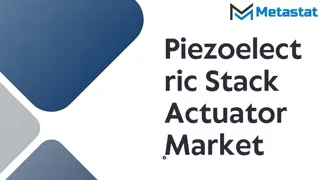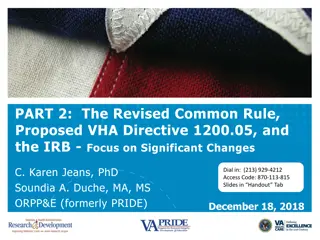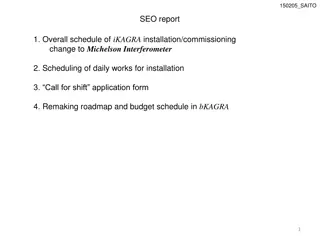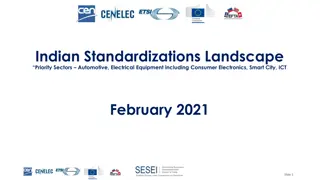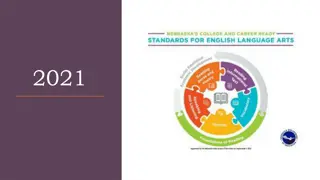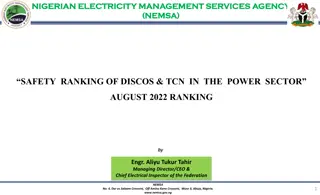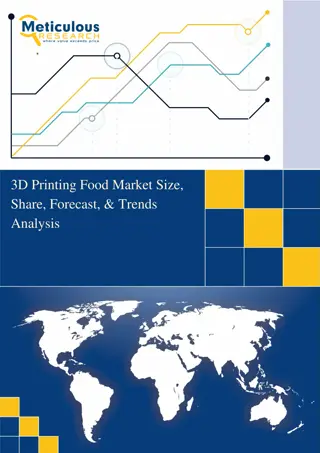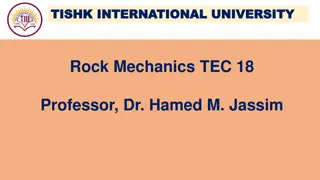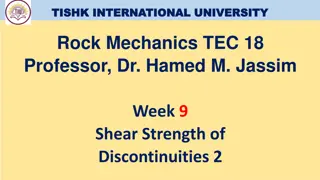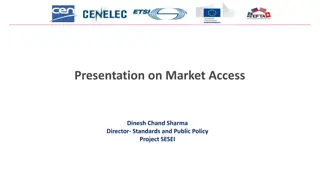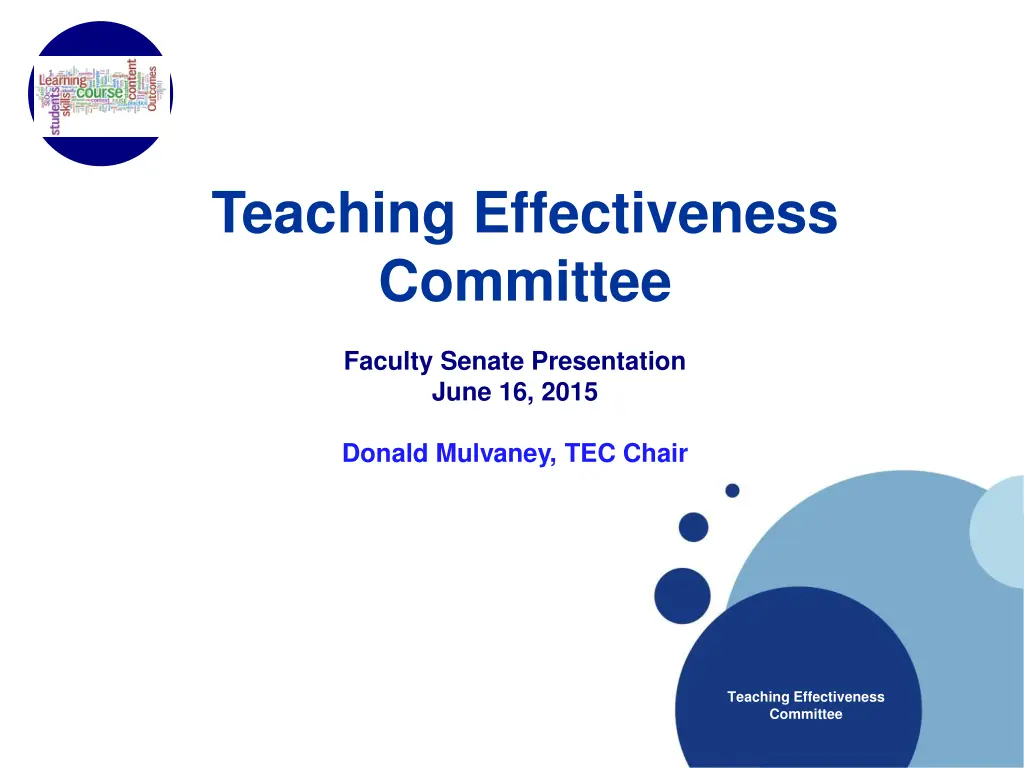
Teaching Effectiveness Committee Overview and Initiatives
Explore the purpose, composition, and initiatives of the Teaching Effectiveness Committee at Auburn University as they focus on reviewing teaching assignments, establishing policy for the Teaching Grant-in-Aid program, evaluating faculty resources, providing faculty development programs, and recognizing teaching excellence.
Download Presentation

Please find below an Image/Link to download the presentation.
The content on the website is provided AS IS for your information and personal use only. It may not be sold, licensed, or shared on other websites without obtaining consent from the author. If you encounter any issues during the download, it is possible that the publisher has removed the file from their server.
You are allowed to download the files provided on this website for personal or commercial use, subject to the condition that they are used lawfully. All files are the property of their respective owners.
The content on the website is provided AS IS for your information and personal use only. It may not be sold, licensed, or shared on other websites without obtaining consent from the author.
E N D
Presentation Transcript
Company LOGO Teaching Effectiveness Committee Faculty Senate Presentation June 16, 2015 Donald Mulvaney, TEC Chair Teaching Effectiveness Committee
Presentation: Review our purpose and composition Report on our ongoing charges and work Project a tentative charge / agenda for 2015-16 Company LOGO 2 2 Slide Teaching Effectiveness Committee Teaching Effectiveness
Our purpose / on-going charge: The committee shall review what is currently in place in the University with respect to appropriate and reasonable teaching assignments. The committee shall establish policy for the Teaching Grant-in-Aid program and review and recommend proposals for funding. It shall also evaluate existing resources for teaching, provide systematic approaches to faculty evaluation, offer formal faculty development programs, and recognize excellence in teaching. Company LOGO 3 3 Slide Teaching Effectiveness Committee Teaching Effectiveness
Our composition: Faculty: Thirteen faculty. Each school or college shall be represented by at least one faculty member Continuing/Ex-officio: Provost or designee, one member from the Instructional Technology Council, One member of the Biggio Center for the Enhancement of Teaching and Learning Undergraduates: One undergraduate student nominated by the Student Government Association Graduate: One graduate student nominated by the Graduate Student Organization Company LOGO 4 4 Slide Teaching Effectiveness Committee Teaching Effectiveness
Our 18 members (2014-2015): Chair, Donald Mulvaney, College of Agriculture 2017 Constance Relihan, Assoc. Provost for UG Studies Continuing Kathy McClelland, Instructional Technology Council Continuing Diane Boyd, Dir. Biggio Center for the Enhancement of Teaching and Learning Continuing Carla Keyvanian, College of Architecture, Design, and Construction 2015 Jill Salisbury-Glennon, EFLT, College of Education 2015 Eva Jean Dubois, School of Nursing 2015 William Ravis, School of Pharmacy 2015 W. Malczycki, College of Liberal Arts 2016 Adit Singh, College of Engineering 2016 Todd Steury, School of Forestry and Wildlife Sciences 2016 Dean Schwartz, College of Vet Med 2016 Karla Teel, College of Human Sciences 2016 John Gorden, College of Sciences and Mathematics 2017 Jaena Alabi, Library 2017 DeWayne Searcy, College of Business 2017 UG Student Representative: Eddie Seay 2015 Graduate Student Rep: Monica Baziotes 2015 Company LOGO 5 5 Slide Teaching Effectiveness Committee Teaching Effectiveness
Charge and Plan of Work 2014-2015 Charge Category 1: Looked at our current student evaluation of teaching (SET) process, how could we determine if this process of evaluation and the instrument currently in use is effective for Auburn University? What might be some possible methods available for reducing the incidence of "NR" grades, which are the grades not reported by faculty as required at the end of the semester? (note: unfinished) Company LOGO 6 6 Slide Teaching Effectiveness Committee Teaching Effectiveness
Charge and Plan of Work 2014-2015 Charge Category 2: review and recommend proposals for funding for the Teaching Grant-in-Aid program and the new Departmental Award for Educational Excellence Charge Category 3: evaluate existing resources for teaching Charge Category 4: Faculty Development - provide systematic approaches to faculty evaluation, offer formal faculty development programs, and recognize excellence in teaching Company LOGO 7 7 Slide Teaching Effectiveness Committee Teaching Effectiveness
Approach for charge 1 2014-2015 Charge Category 1: student evaluation of teaching process, Designing evaluation systems that prompt more reflective, rational input would accord students enhanced respect, improve instruction, and treat faculty colleagues more fairly (Merritt, 2012) Company LOGO 8 8 Slide Merritt, Deborah J. (2012) "Bias, the Brain, and Student Evaluations of Teaching," St. John's Law Review: Vol. 82: Iss. 1, Article 6. Available at: http://scholarship.law.stjohns.edu/lawreview/vol82/iss1/6 Philip B. Stark, a professor of economics at the University of California at Berkeley and co-author of a widely read 2014 paper (www.scienceopen.com/document/vid/42e6aae5-- 246b- 4900- 8015- dc99b467b6e4?0) critical of student evaluations of teaching, said he was even more against them now, given the growing body of evidence of their unreliability -- especially concerning gender bias. https://chronicle.com/article/Everyone-Complains- About/230885/?key=Sm97d19saStAY39qZGoQajdRbn07OE 4gZHVKbS19blxWEg=change Teaching Effectiveness Committee Teaching Effectiveness
Approach for charge 1 2014-2015 Charge Category 1: student evaluation of teaching process The TEC met several meetings the past academic year and discussed this charge at almost every meeting. We sought to determine how we can objectively respond to the question. The committee examined literature related to these questions and solicited input from colleagues within colleges we represent. We sought comparative data from other institutions that we could use to benchmark. For example, a couple of items that provided comparative insight into the low numbers we have realized and fed our discussion in the future were at: Company LOGO 9 9 Slide http://cnu.edu/facultysenate/current/11.19.10/atac.pdf www.innovateonline.info/pdf/vol2_issue6/Online_Student_Evalu ations_and_Response_Rates_Reconsidered.pdf Teaching Effectiveness Committee Teaching Effectiveness
Observations / Recommendations Charge Category 1: current student evaluation of teaching We encourage reinforcement of the fact that course evaluations by students are only one facet of how we evaluate teaching. Any meaningful evaluation should take into account multiple measures of performance. The TEC were satisfied with the global questions currently in use although further review is recommended as we accommodate innovative teaching formats (EASL, etc); This should be a charge for 2015-2016. Best practice: End-of-course evaluations (SET) should be reviewed regularly by colleges and departments to ensure that they reflect the factors that the units consider most important. Company LOGO 10 10 Slide At a minimum, the questionnaire questions should allow for a balanced appraisal of student perceptions of an instructor s preparation, mastery of the material, and delivery. All evaluations should include an opportunity for open-ended responses by students Teaching Effectiveness Committee Teaching Effectiveness
Recommendations Charge Category 1: current student evaluation of teaching All teaching faculty should be encouraged by Departmental and College administrators to make use of the resources within the Biggio Center for the Enhancement of Teaching and Learning Faculty should be encouraged to use informal mid-term evaluations/feedback to determine whether changes are needed to improve student learning and satisfaction Peer observation and feedback are encouraged and are important supports to student evaluations. A well- designed program of peer observation and timely feedback can help faculty adjust to the expectations of the department and college and assist faculty in improving delivery. Each college should evaluate whether its peer review program is meeting these goals and consider ways to use peer reviews to strengthen overall curricular goals Company LOGO 11 11 Slide Teaching Effectiveness Committee Teaching Effectiveness
Additional Observations / Recommendations Charge Category 1: current student evaluation of teaching process Guided by literature, the TEC suggests we may have a problem with validity of the SET and acknowledges uncertainty of it s use by faculty The primary consistent disadvantage to online SET is the low response rate; using reminder e-mails from instructors and messages posted on online class discussions can significantly increase response rates. Company LOGO 12 12 Slide Teaching Effectiveness Committee Teaching Effectiveness
Additional Observations / Recommendations Charge Category 1: current student evaluation of teaching process Evaluation scores really do not seem to change when evaluations are completed online rather than paper (literature) Students tend to leave more comments on online evaluations compared to paper evaluations especially if dissatisfied. Evaluation of online courses involves many of the same criteria applied to traditional classroom courses but the TEC suggests we examine possible criteria or wording based on the online environment. Company LOGO 13 13 Slide Teaching Effectiveness Committee Teaching Effectiveness
Perceptions Charge Category 1: current student evaluation of teaching process Students (see references) Often feel that evaluations have no effect on teacher performance, and they don t seem to know if anyone other than the instructor sees the evaluations believe faculty and administrators don t take their evaluations seriously. Some studies have found that instructors do not view student evaluations as valuable for improving instruction and very few report making changes to their courses as a result of course evaluations. more likely to complete course evaluations if they see value in them (e.g., understand how they are being used, believe that their opinions have an effect). Company LOGO 14 14 Slide Teaching Effectiveness Committee Teaching Effectiveness
Best Practices Charge Category 1: current student evaluation of teaching process Faculty (see references) Should communicate the value of course evaluations, providing examples of how you have used them to improve your courses in the past. Emphasize that results are completely anonymous and confidential. Students are not identified individually and results are not available to instructors until after final exams. Periodically remind students to complete their Web-based course evaluations before the deadline for the current term. Company LOGO 15 15 Slide Teaching Effectiveness Committee Teaching Effectiveness
Response Rate Recommendations Charge Category 1: student evaluation of teaching process RECOMMENDATIONS FOR IMPROVED RESPONSE RATES Company LOGO The literature suggest that there are effective methods to improve response rates on end-of- course evaluations: 16 16 Slide 1) Make evaluation a part of the course (most effective) 2) Continue to send reminder notices 3) Offer a small incentives 4) Encourage faculty to value the AU Evaluate as a formative development item 5) Offer reflection or feedback as how the information is helping or being used Teaching Effectiveness Committee Teaching Effectiveness
TEC Plan of Work / Efforts 2014-2015 Charge Category 2: review and recommend proposals for funding for the Breeden Teaching Grant-in- Aid program and Departmental Award for Educational Excellence Evaluated proposals in the fall (moved from spring) Travel enhancement $2000 Research oriented $4000 Recommended funding ~$30 K of about ten proposals for the 2015 year Company LOGO 17 17 Slide Teaching Effectiveness Committee Teaching Effectiveness
TEC Plan of Work / Efforts 2014-2015 Charge Category 3: evaluate existing resources for teaching Company LOGO 18 18 Regularly reviewed teaching activities around campus Participated in Conversations in Teaching Participated in iTeach program Participated in selection processes for Biggio Center Participated in ad hoc committees Slide Teaching Effectiveness Committee Teaching Effectiveness
TEC Plan of Work / Efforts 2014-2015 Charge Category 4: Faculty Development - provide systematic approaches to faculty evaluation, offer formal faculty development programs, and recognize excellence in teaching Evaluated Departmental Award For Education Excellence (now in 2ndyear) $30,000 Grant / Award that is administered in three yearly installments of $10,000 and used for activities that enhance teaching and learning. Preproposals collected in February Finalists in May Review of written proposals and a departmental presentation Made recommendation to administration Biosystems Engineering will be formally recognized as the recipient during the faculty awards program in the fall Company LOGO 19 19 Slide Teaching Effectiveness Committee Teaching Effectiveness
TEC Plan of Work / Efforts 2014-2015 Non-charge (but desirable) Category 5: Advance the development of members of the Teaching Effectiveness Committee Company LOGO Encouraged seminar and workshop attendance / participation throughout the year 20 20 Slide Teaching Effectiveness Committee Teaching Effectiveness
In Conclusion: Teaching Effectiveness Committee had an active year Significant man-hours invested in evaluation of proposals to designed to promote scholarship and best practices of teaching Examined teaching evaluation process but more evaluation of the AU SET is in order 2015-16 plan of work should include a comprehensive look at AU Eval/ SETs survey faculty views about SETs in their current form relative to helpfulness to them, and if not, what could be done to improve SET administration and use Thanks to each committee member for their commitment, dedication and hard work. Company LOGO 21 21 Slide Teaching Effectiveness Committee Teaching Effectiveness
TEC References for Charge 1 Selected References: Merritt, Deborah J. (2012) "Bias, the Brain, and Student Evaluations of Teaching," St. John's Law Review: Vol. 82: Iss. 1, Article 6. (Available at: http://scholarship.law.stjohns.edu/lawreview/vol82/iss1/6) Clayson and Haley. 2011. Are Students Telling Us the Truth? A Critical Look at Student Evaluation of Teaching, Marketing Educ. Rev. 21:101-112 http://cnu.edu/facultysenate/current/11.19.10/atac.pdf http://www.slate.com/blogs/xx_factor/2014/12/09/gender_bias_in_s tudent_evaluations_professors_of_online_courses_who_present.ht ml http://about.colum.edu/academic-affairs/evaluation-and- assessment/pdf/Course%20Evaluation%20Literature%20Review.p df http://myevals.uncc.edu/faqs/it-possible-increase-response-rates https://www.insidehighered.com/news/2015/06/10/aaup-committee- survey-data-raise-questions-effectiveness-student-teaching. https://chronicle.com/article/Everyone-Complains- About/230885/?key=Sm97d19saStAY39qZGoQajdRbn07OE4gZH VKbS19blxWEg=change Company LOGO 22 22 Slide Teaching Effectiveness Committee Teaching Effectiveness
More observations Charge Category 1: current student evaluation of teaching process Effects of allowing students access to course evaluation data: Students who do not have access to course evaluating ratings, rate course evaluations as more important to making a course selection than those who do have access. This may indicate that students think course evaluation data will be more helpful than it actually is. If all else is equal, a student is twice as likely to choose an instructor with excellent ratings over an instructor with good ratings; however, students are willing to select a poor instructor if they believe they will learn a lot from the class. Students will choose a highly rated course over less highly rated courses even if the workload is greater for that course than the others. Results are mixed on whether receiving evaluation information influences how students consequently rate the instructor. Some studies have indicated that students who receive information that an instructor was rated highly will rate that instructor highly, and vice versa. Company LOGO X X Slide Teaching Effectiveness Committee Teaching Effectiveness
More Observations Charge Category 1: current student evaluation of teaching process, a student who feels strongly, either positively or negatively, about their course experience is very likely to complete an evaluation. A less passionate student may take the time to complete an in-course paper evaluation but may be less likely to respond to an e- mail request to take an electronic survey outside of class. Withholding access to student grades until they have completed their evaluations is technically possible, but university policy does not make course evaluations compulsory. Studies indicate punitive measures such as grade withholding are counterproductive. Students respond more favorably to positive reinforcement, open communication, and persistent messages. Response rates tend to increase if students are informed that their survey responses will improve the course for other students who take the course in the future. Therefore, faculty participation in improving response rates is essential. Company LOGO XX XX Slide Teaching Effectiveness Committee Teaching Effectiveness

